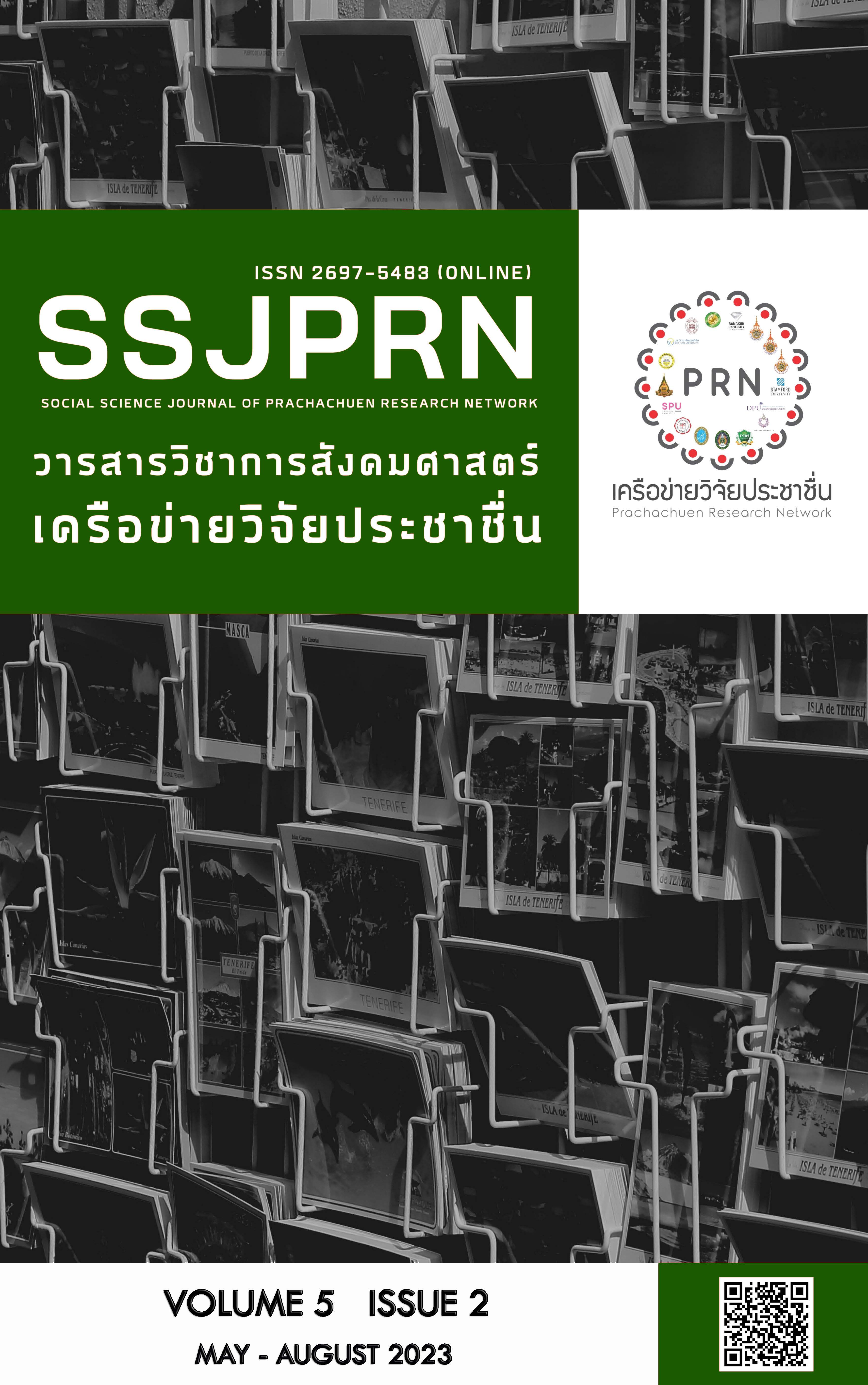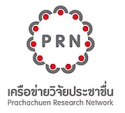แนวทางการพัฒนาสมรรถนะของตัวแทนขายประกันชีวิตในประเทศไทย
คำสำคัญ:
ตัวแทนขายประกันชีวิต, การพัฒนาสมรรถนะ, การพัฒนาทรัพยากรมนุษย์บทคัดย่อ
การวิจัยนี้มีวัตถุประสงค์เพื่อศึกษาสภาพ ปัญหาสมรรถนะของตัวแทนขายประกันชีวิตในประเทศไทย เพื่อเปรียบเทียบความแตกต่างของปัจจัยภายในและปัจจัยภายนอกซึ่งส่งผลกระทบต่อกระบวนการพัฒนาสมรรถนะของตัวแทนขายประกันชีวิต รวมทั้งข้อจำกัดในการพัฒนาสมรรถนะของตัวแทนขายประกันชีวิต เพื่อศึกษา วิเคราะห์ และระบุปัจจัยในการส่งเสริมการพัฒนาสมรรถนะของตัวแทนขายประกันชีวิตในประเทศ และเพื่อนำเสนอแนวทางการพัฒนาสมรรถนะของตัวแทนขายประกันชีวิตในประเทศไทย ซึ่งเป็นการวิจัยแบบผสมผสานโดยใช้ข้อมูลเชิงปริมาณจากการตอบแบบสอบถามของผู้บริหารหน่วยงานบริหารตัวแทนขายประกันชีวิต 411 ราย ด้วยการสุ่มกลุ่มตัวอย่างโดยใช้หลักความน่าจะเป็นจากบริษัทประกันชีวิตในประเทศไทย และข้อมูลเชิงคุณภาพจากการสัมภาษณ์เชิงลึกจากผู้บริหารระดับสูงในหน่วยงานบริหารตัวแทนขายประกันชีวิต นักวิชาการด้านธุรกิจประกันชีวิต และเจ้าหน้าที่ภาครัฐในหน่วยงานกำกับดูแล จำนวนรวม 17 คน
ผลการวิจัยพบว่า ปัจจัยระดับหน่วยงานบริหารตัวแทนขายประกันชีวิต จำนวนตัวแทนขายประกันชีวิตที่กำกับดูแล และจำนวนกรมธรรม์ประกันชีวิตใหม่ที่รับผิดชอบในแต่ละปี เป็นปัจจัยที่ส่งผลกระทบต่อกระบวนการพัฒนาสมรรถนะของตัวแทนขายประกันชีวิต โดยมีนัยสำคัญทางสถิติที่ระดับ .05 และ .01 ตามลำดับ จากการวิเคราะห์ถดถอยพหุคูณ พบว่า กระบวนการพัฒนาทรัพยากรมนุษย์มีความสัมพันธ์อย่างมีนัยสำคัญทางสถิติกับสมรรถนะของตัวแทนขายประกันชีวิตโดยรวม ได้แก่ สมรรถนะด้านความรู้ความเข้าใจด้านผลิตภัณฑ์ประกันชีวิต สมรรถนะด้านการสื่อสาร สมรรถนะด้านการตัดสินใจ สมรรถนะด้านการสร้างความสัมพันธ์ สมรรถนะด้านการคิดวิเคราะห์และแก้ปัญหา และสมรรถนะด้านการปรับตัวและใช้เทคโนโลยี โดยเฉพาะอย่างยิ่งการประเมินการพัฒนาทรัพยากรมนุษย์ซึ่งส่งผลต่อการพัฒนาสมรรถนะของตัวแทนขายประกันชีวิตทุกด้านอย่างมีนัยสำคัญทางสถิติที่ระดับ .05 และ .01 ทั้งนี้การสังเคราะห์แนวทางการพัฒนาสมรรถนะของตัวแทนขายประกันชีวิตได้แนวทางการจัดการ 8 แนวทาง ที่สามารถตอบสนองต่อการพัฒนาสมรรถนะของตัวแทนขายประกันชีวิตในประเทศไทยได้
References
Albliwi, S. A., Antony, J., Lim, S. A., & van der Meer, R. (2019). Human resource development practices and employee retention in the healthcare sector: A systematic review. International Journal of Quality & Reliability Management, 36(6), 937-954.
Anagol, S., Cole, S., & Sarkar, S. (2017). Understanding the advice of commissions-motivated agents: Evidence from the Indian life insurance market. Review of Economics and Statistics, 99(1), 1-15.
Bal, P. M., Bagdadli, S., Kossek, E. E., & Isik, I. (2020). How do high-performance work systems affect individual outcomes: A multilevel perspective. Human Resource Management Journal, 30(1), 93-113.
Beardwell, J., Claydon, T., & Holden, L. (2019). Human Resource Management: A Contemporary Approach. Boston, MA: Pearson Education.
Best, J.W., & Khan, J.V. (1998). Research in Education (8th ed.). Boston: Allyn & Bacon, 1998.
Brown, D. R., & Harvey, D. (2018). An Experiential Approach to Organization Development. New York, NY: Pearson Education.
Chaganti, R., & Sitasamit, N. (2019). Factors Affecting the Effectiveness of Life Insurance Agent Training Programs: Evidence from Thailand. The Geneva Papers on Risk and Insurance-Issues and Practice, 44(2), 267-285.
Cheng, B. (2017). Factors Influencing the Effectiveness of Life Insurance Agent Training in China. Journal of Insurance Issues, 40(1), 1-24.
CNA National Honor Society (2016). Training and education key to insurance success. Retrieved from https://www.cnains.org/training-and-education-key-to-insurance-success/
Janowski, A. (2016). From Competency Management to Organizational Effectiveness: Evidence for Live Insurance Industry in Central Europe. Przedsiębiorczość i Zarządzanie, 17(10.2), 37-52.
Jiang, W., Ji, Q., Zhang, X., & Shi, Y. (2020). The effect of human resource development practices on employee creativity and innovation: The moderating role of learning orientation. Frontiers in Psychology, 11, 336.
Joo, B. K., Yu, J. W., & Kim, Y. K. (2019). Impact of technology adoption capabilities on customer satisfaction: Focusing on Korean life insurers. Sustainability, 11(2), 548.
Kajwang, B. (2022). Importance of education and skills on performance of insurance sector. Journal of Strategic Management, 7(1), 13-21.
Kim, H., Hur, D., & Kim, B. (2014). The effects of relationships on customer loyalty in the life insurance industry. Social Behavior and Personality: An International Journal, 42(1), 73-85.
Kraiger, K., Ford, J. K., & Salas, E. (2016). Application of Cognitive, Skill-Based, and Affective Theories of Learning Outcomes to New Methods of Training Evaluation. Journal of Applied Psychology, 101(8), 1248-1262.
Krejcie, R. V., & Morgan, D. W. (1970). Determining sample size for research activities. Educational and Psychological Measurement, 30(3), 607-610.
LIMRA (2018). Developing agents for success: Perspectives from the frontline. Retrieved from https://www.limra.com/en/resources/research/research-abstracts/developing-agents-for-success-perspectives-from-the-frontline/
Macmillan, T.T., (1971). The Delphi Technique., Paper Presented at the annual meeting of the California Junior Colleges Associations Committee on Research and Development, Monterey, California. 3-5.
Marinkovic, M., & Radojevic, T. (2018). The role of communication competence in achieving client satisfaction in insurance. Economic Themes, 56(1), 55-70.
Negi, S., & Thite, M. (2019). Human resource development practices across countries: Impact of national culture and economic development. Journal of World Business, 54(1), 54-65.
Office of Insurance Commission. (2016). A Practical Guide for Life Insurance Agents: Application for a Life Insurance Agent License. Retrieved from: https://www.oic.or.th/sites/default/files/content/85942/rwmelm-tch-0.pdf.
Office of Insurance Commission. (2021). Report on the state of the Thai insurance industry for the first three months of 2021. Retrieved from: https://www.oic.or.th/sites/default/files/content/92256/samenaaraayngaanphaawathurkicchprak.pdf
Pareto Academy. (2019). The digital landscape: what agents need to know. Retrieved from https://www.paretoacademy.com/competencies-insurance-agents/
Pasmore, W. A., & Francis, C. (2017). Strategic organizational development interventions: Lessons from the field. The Journal of Applied Behavioral Science, 53(4), 451-473.
Sun, L., Zhao, D., & Liu, Y. (2020). Multi-attribute decision model for life insurance salesperson's multi-period sales decision-making problem. Symmetry, 12(7), 1176.
The Thai Life Assurance Association. (2021). 2020 Life Insurance Industry Statistics Report Retrieved from: https://www.tlaa.org/page_statistics_new.php?cid=81.
Weihrich, H. (1982). The TOWS Matrix a Tool for Situational Analysis. Long Range Planning, 15(2), 54-56. Retrieved from https://www.sciencedirect.com/science/article/abs/pii/0024630182901200.
Wilson, J. P. (2005). Human Resource Development: Learning & Training for Individuals and Organizations. London, UK: Kogan Page.
Yan, R., Luo, G., & Zhang, Y. (2015). Micro-environmental forces, market entry mode, and life insurer performance in China. Journal of Insurance Issues, 38(2), 115-141.
Yang, Y., Xin, J., & Pan, Y. (2019). Analytical thinking competency of the agent in the insurance industry. Performance Improvement Quarterly, 31(4), 301-323.
Downloads
เผยแพร่แล้ว
How to Cite
ฉบับ
บท
License
Copyright (c) 2023 วารสารวิชาการสังคมศาสตร์เครือข่ายวิจัยประชาชื่น

This work is licensed under a Creative Commons Attribution-NonCommercial-NoDerivatives 4.0 International License.
บทความที่ได้รับการตีพิมพ์เป็นลิขสิทธิ์ของวารสารวิชาการสังคมศาสตร์เครือข่ายวิจัยประชาชื่น






